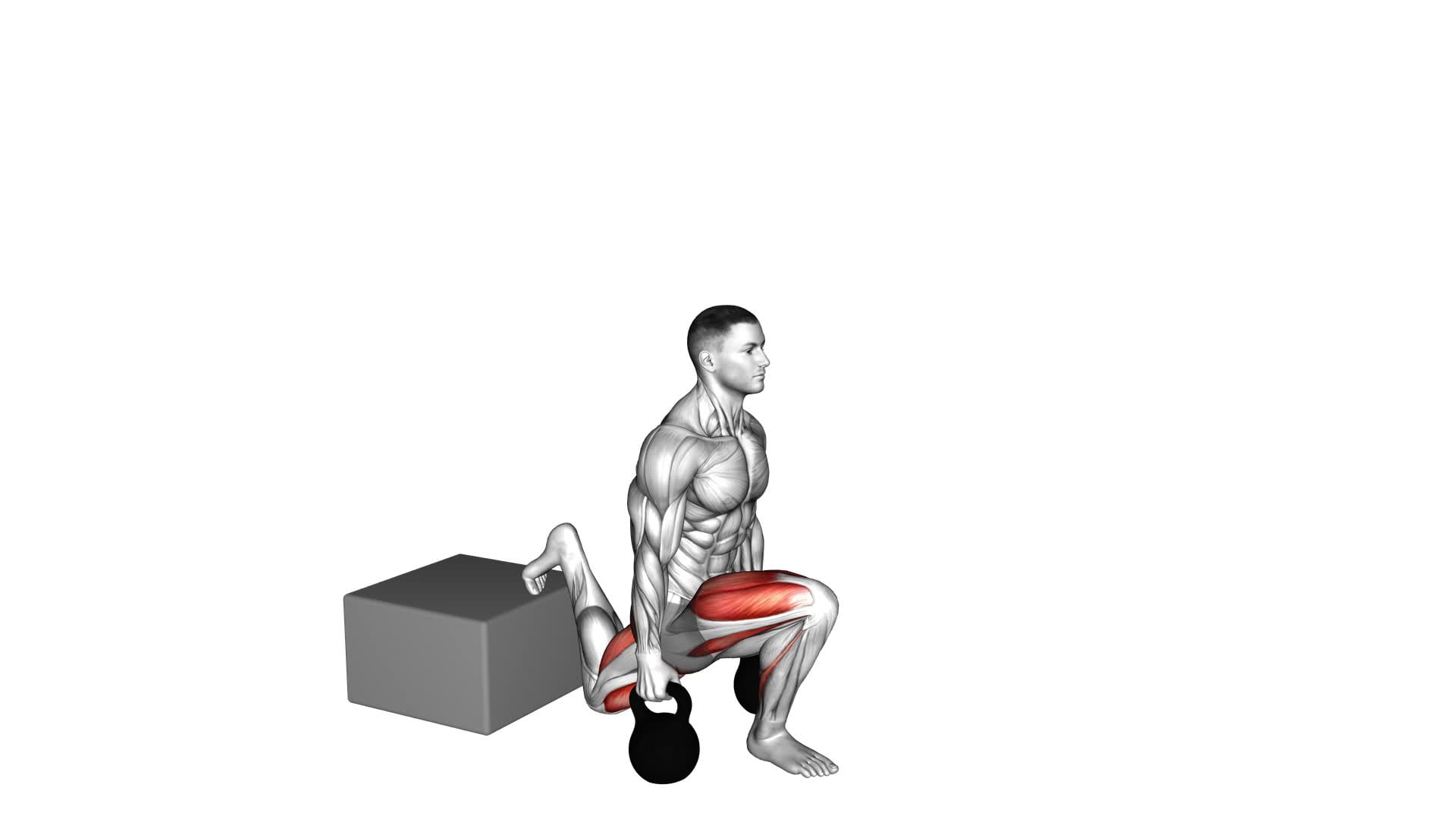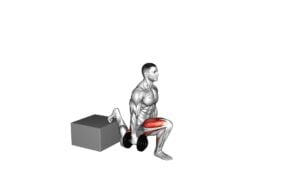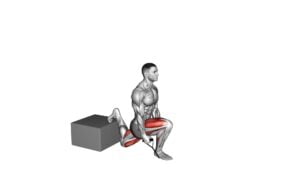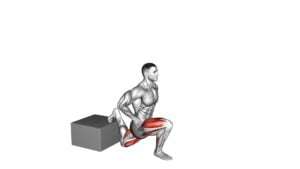Kettlebell Single Leg Split Squat With Low Box – Video Exercise Guide & Tips

Are you looking for a challenging lower body exercise that targets your quads, glutes, and hamstrings? Look no further than the Kettlebell Single Leg Split Squat with Low Box!
Watch This Exercise Video
In this video exercise guide, we'll show you the proper form and technique to maximize your results. Avoid common mistakes and take your workouts to the next level with our helpful tips.
Get ready to feel the burn and strengthen your legs with this effective kettlebell exercise.
Key Takeaways
- The Kettlebell Single Leg Split Squat improves balance and strengthens glutes.
- It challenges stabilizing muscles and enhances overall balance.
- The exercise helps prevent falls and injuries.
- Proper form and technique are important, including aligning the knee with the ankle and maintaining a neutral spine.
Benefits of the Kettlebell Single Leg Split Squat
You should regularly perform the kettlebell single leg split squat to maximize its benefits. This exercise is highly effective for improving balance and strengthening the glutes. By focusing on one leg at a time, you challenge your stabilizing muscles and enhance your overall balance. This is especially beneficial for athletes, as well as individuals looking to prevent falls and injuries.
Additionally, the kettlebell single leg split squat targets the glute muscles, which are crucial for stability and power in movements such as running, jumping, and lifting. Strong glutes not only improve athletic performance but also help alleviate lower back pain and improve posture.
To perform this exercise, you'll need a kettlebell and a low box or step. The kettlebell provides an added resistance to increase the intensity of the exercise, while the low box serves as a guide for maintaining proper form and depth. It's important to choose a kettlebell weight that challenges you but still allows you to maintain proper technique. As for the low box, make sure it's sturdy and at a height that allows you to comfortably reach parallel or slightly lower with your back knee.
Now that you understand the benefits and the equipment needed for the kettlebell single leg split squat, let's move on to the next section: proper technique and form.
Equipment Needed for the Exercise
To perform the kettlebell single leg split squat with a low box, you'll need specific equipment.
The main piece of equipment required for this exercise is a kettlebell. Kettlebells are versatile and effective tools for strength training, offering numerous benefits over traditional dumbbells or barbells. They provide a unique combination of strength and cardio training, helping to improve muscular endurance, flexibility, and overall fitness.
In addition to the kettlebell, you'll also need a low box or step. This box should be sturdy and stable enough to support your weight during the exercise. The height of the box can vary depending on your fitness level and comfort, but it should be low enough to allow for proper form and range of motion.
There are variations of the single leg split squat that can be performed with different equipment, such as dumbbells or a barbell. However, using a kettlebell adds an additional challenge by requiring more stability and coordination. It also targets the muscles in a slightly different way, making it a great option for those looking to switch up their routine or challenge themselves further.
Proper Form and Technique for the Kettlebell Single Leg Split Squat
To perform the kettlebell single leg split squat with a low box, focus on maintaining proper form and technique throughout the exercise. Proper form is crucial to ensure maximum effectiveness and minimize the risk of injury.
One common mistake isn't aligning the knee properly with the ankle during the squat. To avoid this, make sure your knee stays directly above your ankle, not extending past it.
Another mistake is leaning too far forward, which can put excessive strain on your lower back. To maintain better balance, engage your core and keep your torso upright throughout the movement. Additionally, keep your gaze forward and avoid looking down, as this can throw off your balance.
It's also important to use a weight that's suitable for your strength level. Starting with a lighter kettlebell and gradually increasing the weight as you become more comfortable and proficient with the movement is recommended.
Common Mistakes to Avoid During the Exercise
Maintaining proper form and technique is crucial during the kettlebell single leg split squat with a low box. There are several common mistakes to avoid:
- Allowing the knee of the front leg to go past the toes. This puts unnecessary strain on the knee joint and reduces the effectiveness of the exercise. To avoid this, focus on sitting back into the squat and keeping the weight in the heel of the front foot.
- Not maintaining a neutral spine. It's important to keep your chest up and your core engaged throughout the exercise.
- Lack of balance and stability. It's common to lose balance or wobble during this exercise, especially with a heavier kettlebell. To improve stability, start with a lighter weight and gradually increase as you become more comfortable.
- Rushing through the exercise. Take your time and focus on proper technique.
By avoiding these common mistakes, you'll be able to perform the kettlebell single leg split squat with a low box more effectively and minimize the risk of injury.
In the next section, we'll discuss some tips to maximize your results with this exercise.
Tips to Maximize Your Results With the Kettlebell Single Leg Split Squat
To maximize your results with the kettlebell single leg split squat, it's important to focus on proper form and technique while incorporating this exercise into your routine. Here are some tips to help you get the most out of this exercise:
- Maintain proper alignment: Keep your chest up, shoulders back, and core engaged throughout the movement. This will help you maintain balance and stability.
- Control your descent: Avoid rushing through the lowering phase of the squat. Lower yourself slowly and with control to engage your muscles more effectively.
- Keep your knee aligned: Make sure your knee stays aligned with your toes throughout the movement. This will help prevent unnecessary strain on your joints.
- Common mistakes to avoid: Watch out for leaning too far forward, rounding your back, or allowing your knee to cave inward. These mistakes can lead to poor form and increase the risk of injury.
- Variations and progressions: Once you have mastered the basic kettlebell single leg split squat, you can try adding more weight or using different variations, such as holding the kettlebell in a goblet position or performing the exercise on an unstable surface like a balance board.
Frequently Asked Questions
How Many Sets and Repetitions Should I Do for the Kettlebell Single Leg Split Squat?
For the kettlebell single leg split squat, it's important to find the optimal weight and maintain proper form. Start with a weight that challenges you but allows for good technique.
Aim for 3-4 sets of 8-12 repetitions per leg, depending on your fitness level. If you're a beginner, you can modify by using a lower weight or performing the exercise without a kettlebell.
As you progress, you can increase the weight or try variations like adding a hop at the top.
Can I Perform the Kettlebell Single Leg Split Squat if I Have Knee or Ankle Injuries?
If you have knee or ankle injuries, it's important to be cautious when performing the kettlebell single leg split squat. This exercise puts pressure on those areas, so modifications may be necessary.
Consider alternative exercises that are gentler on the knees and ankles, such as lunges or step-ups.
It's always best to consult with a healthcare professional or a certified trainer who can guide you in finding safe and effective options for your specific condition.
Is It Better to Use a Lighter or Heavier Kettlebell for This Exercise?
When deciding whether to use a lighter or heavier kettlebell for the single leg split squat, consider your fitness level and goals.
Using a lighter kettlebell may be beneficial if you're just starting out or focusing on form. It allows you to focus on stability and control.
On the other hand, using a heavier kettlebell can increase the intensity and challenge your muscles more.
Kettlebells have unique benefits for this exercise, such as engaging multiple muscle groups and improving balance, compared to other equipment.
Can I Substitute the Kettlebell With a Dumbbell or Any Other Equipment?
When it comes to the kettlebell single leg split squat, you might be wondering if you can substitute the kettlebell with a dumbbell or any other equipment.
Well, the good news is that there are alternatives to using a kettlebell in this exercise. You can try using a dumbbell, a medicine ball, or even just your body weight.
These modifications can still give you a great workout and help you build strength in your legs and glutes.
How Long Should I Rest Between Sets During the Kettlebell Single Leg Split Squat Workout?
When doing the kettlebell single leg split squat workout, it's important to give yourself enough rest between sets. This will allow your muscles to recover and perform at their best.
Generally, it's recommended to rest for about 1-2 minutes between sets. However, the exact amount of rest time may vary depending on your fitness level and personal preferences.
Listen to your body and adjust the rest time accordingly to maintain proper form and technique throughout the workout.
Conclusion
In conclusion, the kettlebell single leg split squat with a low box is a highly effective exercise for targeting the lower body muscles. By using proper form and technique, you can maximize your results and avoid common mistakes.
This exercise requires minimal equipment and offers numerous benefits, including improved strength, balance, and stability. Incorporate the kettlebell single leg split squat into your workout routine to enhance your overall fitness level.

Author
Years ago, the spark of my life’s passion ignited in my mind the moment I stepped into the local gym for the first time. The inaugural bead of perspiration, the initial endeavor, the very first surge of endorphins, and a sense of pride that washed over me post-workout marked the beginning of my deep-seated interest in strength sports, fitness, and sports nutrition. This very curiosity blossomed rapidly into a profound fascination, propelling me to earn a Master’s degree in Physical Education from the Academy of Physical Education in Krakow, followed by a Sports Manager diploma from the Jagiellonian University. My journey of growth led me to gain more specialized qualifications, such as being a certified personal trainer with a focus on sports dietetics, a lifeguard, and an instructor for wellness and corrective gymnastics. Theoretical knowledge paired seamlessly with practical experience, reinforcing my belief that the transformation of individuals under my guidance was also a reflection of my personal growth. This belief holds true even today. Each day, I strive to push the boundaries and explore new realms. These realms gently elevate me to greater heights. The unique combination of passion for my field and the continuous quest for growth fuels my drive to break new ground.







